A Rose by Any Other Name...
 |
| An artist's conception of a blazar. Image credit: NASA/Honeywell Max Q Digital Group, Dana Berry. |
EUVE J1104+38.1, QSO B1101+384, RX J1104.4+3812, and dozens of other aliases are used to refer the object more commonly known as Markarian 421 - or, Mrk 421, Mkn 421, or Mark 421 for short. According to the Simbad Astronomical Database, Mark 421 is known by 59 identifiers! Why such popularity with so many cataloged names? Appearing stellar in nature to the average optical astronomer, Mark 421 is actually an extraordinary object. Broadly classified as a member of the Active Galactic Nuclei (AGN), Mark 421 is a galaxy with, as the name implies, an extremely active central region. And unlike ordinary stars that may shine in a narrow band of the electromagnetic spectrum, Mark 421 can be seen across the entire spectrum of wavelengths, from radio to gamma rays!
Subclassified as a BL Lac object, Mark 421 is one of the closest entities of its kind. Situated at 400 million light years from Earth, Mark 421 is kept under close surveillance by professionals. However, with so many windows of the electromagnetic spectrum to cover, the professional astronomer rarely observes this object at optical wavelengths. Instead, scientists depend on the vigilance of the amateur astronomer to help fill in this band of wavelengths. As such, Mark 421 stands a perfect example of professional and amateur cooperation!
The Active Galactic (Family) Nucleus
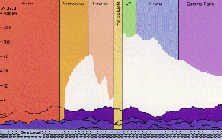 |
| In order to "see" at some wavelengths, astronomers literally had to get their equipment off the ground. While visible light, radio, and some microwave can be detected from Earth's surface, the remaining bands can only be detected by going beyond sea level and/or Earth's atmosphere. Image credit: Imagine the Universe. Click image to enlarge. |
While most of the radiation emitted from a "normal" galaxy is in the form of visible light, like that of the radiation of ordinary stars, AGNs are prominent across the entire electromagnetic spectrum. Thus, astronomers needed to look beyond the visual regime to see their full potential. Recent technological advancements, such as satellite deployment, have enabled astronomers to explore energies once unattainable. In addition to the showing in a wide range of energies, AGNs also change in brightness on time scales from minutes to decades. It's no wonder then that some stars once thought to be variable, such as W Comae, AP Librae, and BL Lacertae, were in fact AGN. Only decades in the making, the study of Active Galactic Nuclei (AGN) is a fairly recent branch of astronomy.
Since the conditions of the universe when these objects were forming were different, AGNs may play a crucial role in helping astronomers piece together the early workings of the universe. In fact, AGNs may be the first objects of matter to coalesce after the Big Bang. Quasars (discussed below), in particular, may be an important key. "They [quasars] are observed almost to a redshift of 5; that is, back to when the universe was only 7 percent of its present age. If the universe turns out to be, say, 13 billion years old, quasars were alive 12 billion years ago. They are the earliest coherent structures seen" (Finkbeiner 1992). Perhaps AGNs were common in early galaxies. In a dense, young universe. expansion was not as great as it is now. Galaxies were closer and more likely to collide, perhaps giving rise to more energetic galaxies. Alternatively, it is thought that perhaps every galaxy goes through an active phase.
Regardless, astronomers have found that there are actually several main types of active galaxies: Seyfert galaxies, quasars, and blazars. Although they exhibit slightly different properties, it is believed that they may actually be the same objects but seen at different orientations from here on Earth.
Seyfert Galaxies
 |
| This image of NGC 7742 looks an awful lot like a fried egg, but it is actually a Seyfert galaxy about 3,000 light-years across. Image credit: Hubble Heritage Team (AURA/STScI/NASA). Click image to enlarge. |
The first rung in the ladder of AGN discoveries came in the 1940s by graduate student Carl Seyfert, at Mount Wilson Observatory. Seyfert was studying an interesting class of (mainly) spiral galaxies. While most normal galaxies show continua with absorption lines from normal stars, these galaxies additionally showed strong emission lines that were too broad and of ionization too high to be produced by the galaxy's stellar population. As these galaxies came to bear the discover's name, Seyferts seemed to emanate nearly all their radiation from a central region.
Seyfert galaxies are divided into two classes in the following manor: 1) those that have certain emission lines much broader suggesting gas with high velocities and 2) those that have similar width narrow emission lines, indicating slower moving gas (Hewitt & Poyner 1999). Astronomers found that Seyfert 1 type galaxies sometimes dim and flare by 50% or more in only a month or so. The variations imply that the size of the object could be no larger than a light-month in diameter (Finkbeiner 1992).
Quasars
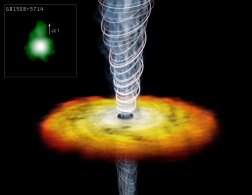 |
| Emerging from quasar GB1508+5714 is the most distant X-ray jet discovered yet at 12 billion light-years away. The illustration depicts the geometry of the false-color X-ray image shown in the upper-left-hand corner. Credit: A. Siemiginowska (CfA) et al., CXC, NASA and Illustration by M.Weiss (CXC). |
The popularity of radio astronomy in the 1950s unveiled yet more astronomical puzzles. One of the first enigmas was the radio galaxy. While unassuming at optical wavelengths, these bodies, which consisted of a pair of extended radio lobes on either side of an elliptical galaxy, proved to be quite interesting in the radio band. Then in the 1960s, radio sources were found to be associated with objects assumed to be stellar in origin. First came the detection of 3C 48, which was initially referred to as a "radio star" later to be called a QUasi Stellar Radio Source, or quasar. The spectrum of another target, 3C 273, obtained by Maarten Schmidt at the Mount Palomar 200-inch telescope during an occultation by the moon revealed that the lines were indeed familiar spectral features, but redshifted to an unprecedented degree. It was found that these faint "stars" were not stars and were not only beyond our own galaxy, but were the most distant galaxies known (Hewitt & Poyner 1999). It was during this time that Allan Sandage says, "holy Ned broke loose. From 1960 to 1970 all the spectroscopists ran into the field. It was a Barnum and Bailey Circus, both at the telescope and in the journals" (Finkbeiner 1992).
Quasars are bright and are seen to vary at all energies. Having derived from radio discoveries, many quasars found interestingly do not emit radio waves in a detectable amount. Such are called quasi-stellar objects (QSO), but are lumped together in the category of quasar. In general, quasars actually are best seen and surveyed at X-ray (Finkbeiner 1992). While quasars have spectra similar to Seyfert galaxies, they tend to be farther away than Seyferts and appear point-like to the optical astronomer.
Blazars
Like quasars, blazars appear point-like in the sky and emit energies from radio to gamma-ray, but are not as luminous. Blazars are the most variable of all the AGNs and can change in brightness by up to a factor of 100 in a few months (Finkbeiner 1992). A blazar is a broader term used to include "BL Lacertae objects and those quasars which share their characteristics of unusually weak spectral features, plus strong and rapid variability" (Keele 2003). There are two subgroups for blazars: 1) sources showing strong and broad emission lines, such as those of quasars (called Flat Spectrum Radio Quasars) 2) sources showing a featureless optical spectrum (BL Lac objects). Named for the prototype, BL Lac objects were first discovered in the 1970s. As the naming convention suggests, this object was once thought to be a variable star.
In the Belly of the Beast
 |
| A diagram of an AGN. Image credit: Imagine the Universe. |
So what is the source of the energetic AGN? The powerhouse is said to come from the nucleus of the active galaxy where it is believed that a supermassive blackhole resides. The super compact object may possess the mass and gravitational pull of a million to a few billion Suns, with a resulting diameter of less than one light-minute to several light-days. The geometry of the system continues, such that surrounding the massive central region is an accretion disk, perhaps extending out a few light-months. Beyond the accretion disk, circling about is a doughnut-shaped torus of dust and gas extending out another couple of light-years, which glows in the infrared (Finkbeiner 1992).
Due to the physics of the accretion disk, the inner disk rotates more quickly than the outer portions. The inner parts near the black hole are spinning so rapidly and are so hot that high-energy wavelengths are generated. A massive amount of energy is emitted when matter accretes onto the black hole via the accretion disk, where a large amount of gravitational energy is released. In some AGNs, radio jets are produced which protrude perpendicular and in opposite directions from the disk, spewing energetic particles at nearly the speed of light. Although it is uncertain how the jets are produced, the shorter wavelengths may be caused by shock waves within the jets. What we see depends upon the orientation of the system. Looking at the jet straight on, we see blazars and quasars. However, if the jet is not pointed in the direction of our line of sight then the dusty disk of the galaxy lies in the plane of view and we see Seyferts. In the case of Markarian 421, one of the jets appears to be oriented in the direction of Earth.
Markarian 421 in Visible Light
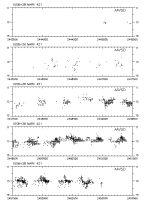 |
| Left: the AAVSO light curve of Mark 421. Click to enlarge. |
In comparison to some of the other variables known (mainly variable stars), AGNs are relative newcomers to the variability scene. Mark 421 joined the ranks of the AAVSO International Database over two decades ago. Since 1982, over 90 observers worldwide have contributed over 3,300 observations to the light curve for this object. Based on these observations, Mark 421 has been seen to vary between 12th and 14th magnitude.
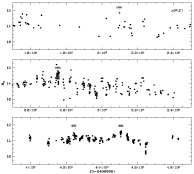 |
| The long-term light curve of Mark 421 by Liu et al. (1997). Click to enlarge. |
For a historical look at Mark 421's behavior, Liu et al. (1997) compiled the data from 22 publications to assemble a long-term light curve dating back to 1900. In their study, the B band was used since more data was available in that band than any other. The team found that in the past decade brightness variations ranged from 11.6 to 16. Analysis of the light curve revealed that Mark 421 undergoes non-periodic, rapid variations on time scales of hours to days. Additionally, they found periodic behavior occurring at 23.1 +/- 1.1 years, with another possible period of 15.3 +/- 0.7 years. However, the team admits the latter may not carry much significance.
Living in the Shadow
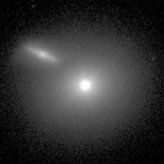 |
| Mark 421 and its companion galaxy, 421-5. Image credit: Aimo Sillanpaa, Nordic Optical Telescope. |
Sitting just 14" east-northeast of Mark 421 is what appears to be an unassuming companion galaxy. Based on Hubble Space Telescope (HST) images, the neighbor, called Mark 421-5, has a bright, compact nucleus that may be an early-type spiral galaxy. Gorham et. al (2000) suggest that Mark 421-5 contains a Seyfert-like nucleus, but does not have any detectable emission lines according to ground-based studies. It is thought that the companion is within the potential well of Mark 421 and may be sweeping through its stellar halo. Astronomers think that AGNs may be associated with galaxy mergers or encounters, as a significant number of BL Lac objects seem to be associated with close companions or nearby galaxies (Gorham et al. 2000 and references therein).
One for the Records
 |
| Artist's conception of what it would look like if the black hole is oriented such that the jets are along the line-of-sight. In this case we would see a bright source of gamma rays. Image credit: NASA/Honeywell Max Q Digital Group, Dana Berry. |
In May 1996, Mark 421 bellowed out the largest flux of gamma rays that had been recorded for an astronomical object, as detected by astronomers at Whipple Observatory in Arizona. The International Astronomical Union Circular 6397 carried the news that, "The source [Mark 421] was observed on May 7 with the 10-m optical reflector under perfect observing conditions. Using the standard Whipple observing and analysis technique, we detected a signal at the 56-sigma level in 2 hr of observation with a doubling time of 1 hr. The energy threshold for the analysis was about 350 GeV...The average rate of 9.5 gamma-rays/min is five times larger than for any previous observation (six times the level of the Crab Nebula) and is the brightest TeV signal recorded by us from any source to date" (Weekes 1996). The terra-electron volt (TeV) has the energy of an electron accelerated by a trillion volts! These highly energetic gamma rays represent an extreme form of radiation so energetic that no particle accelerator here on Earth can reproduce them!
Wanjek (2003), describes the surprise astronomers have come to see in the face of gamma-ray astronomy:
"Forty years ago, the term 'gamma-ray astronomy' was an oxymoron. There was astronomy, and there was physics. Gamma rays, the most energetic form of light, belonged to the later. Rarely did the disciplines mix. Astronomers' eyes would glaze over with the mere mention of gamma rays and all that they entailed: matter-antimatter annihilation, particle decay, scintillation counters, and the like. Gamma rays were just junk radiation caused by cosmic-ray collisions. Few astronomers ever imagined their study would yeild answers to the workings of the universe."
Contribute to Scientific Research
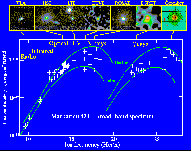 |
| Mark 421 across the spectrum. Click to enlarge. |
Interested in helping astronomers learn more about Mark 421 and the AGN family? While many of the known AGNs may only be attainable with very large and sophisticated instruments, some of the brighter ones are accessible with amateur telescopes. If you're not currently observing AGNs, consider adding some to your observing program. Both visual and CCD observations are needed!
Mark 421 resides in the constellation of Ursa Major and can be found about 2 arc minutes southwest of the bright 6th magnitude star, 51 UMa. Observers should make magnitude estimates at least once a week and submit them to the AAVSO as soon as possible. Be sure to keep an eye out for special observing campaigns in case the need for observational frequency increases. AAVSO charts are available online. CCD observers are encouraged to observe in the V band at the minimum, and the I band if possible. If time permits, R and B (in order of priority) filters are also encouraged, as data at differing wavelengths, even visual, will be beneficial to astronomers in piecing together the AGN puzzle.
Recently, the AAVSO has teamed up with the Gamma-ray Large Area Space Telescope (GLAST) Telescope Network (GTN) monitor blazars in support of the upcoming 2007 GLAST mission. The objective of the partnership is to set up a baseline of data created by long-term monitoring. Then when GLAST is launched, the monitoring will continue so that GLAST can be notified of activity, in addition to being correlated with multiwavelength campaigns. The automated variable star news system, MyNewsFlash, can be personalized for notification of these GTN opportunities. Such a call for observations was put out in CCD Views #313 when Mark 421 appeared to be in outburst in X-ray wavelengths. AAVSOers were asked to monitor the AGN while observations were made with an X-ray satellite and at Whipple Observatory. For more information about this exciting AAVSO-GTN project, click here. Also, be sure to see An Amateur Survey With Professional Results.
For More Information
- AAVSO VSOTM for January 2001: BL Lacertae
- CCD Views #313
- Finkbeiner, A. "Active Galactic Nuclei." Sky & Telescope, August 1992, 138-144.
- Gorham, P.W., L. van Zee, S.C. Unwin, and C. Jacobs. "Markarian 421's Unusual Satellite Galaxy." The Astronomical Journal, 2000, 119, 1677-1686.
- Keele, W. "Introduction - Discovery of Active Galactic Nuclei." online article, 2003.
- Liu, F.K., B.F. Liu, and G.Z. Xie. "The Long-term Optical Behavior of Mkn 421." Astronomy and Astrophysics Supplement Series, 123, 1997, 569-574.
- Hewitt, N. and G. Poyner. "Active Galactic Nuclei and the Amateur." The Deep Sky Observer, the quarterly journal of the Webb Society, April 1999.
- Wanjek, C. "Gamma-ray Astronomy Archives." Sky & Telescope, August 2003, 38-44.
- Weekes, T. International Astronomical Union Circular 6397, 1996.
More Interesting Stuff on the Web
- An Amateur Survey With Professional Results
- Blazars in the Web
- Gamma-ray Large Area Space Telescope (GLAST) Telescope Network (GTN)
- Quasars and Active Galactic Nuclei
- Gamma-Rays and Blazars
This month's Variable Star of the Season was prepared by Kerri Malatesta, AAVSO Technical Assistant.

